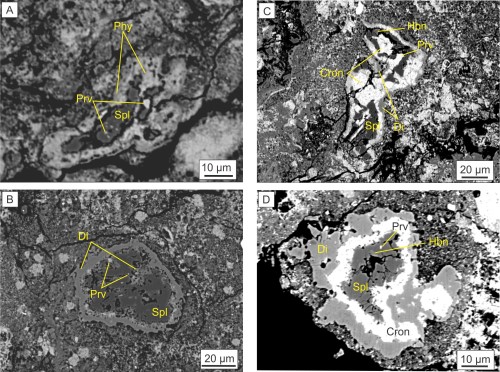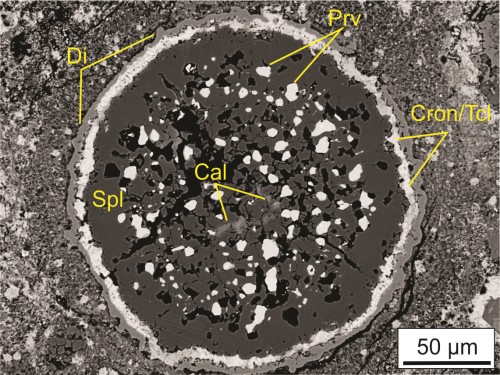The case of melilite absence from CM2 meteorites: the example from the Antarctic AMU 17290 meteorite
- Agricultural University of Athens, Laboratory of Mineralogy and Geology
Introduction
Calcium-aluminum-rich inclusions (CAI) in carbonaceous chondrites are considered to be of the most primitive objects, formed during the nebula phase of the Solar System [1]. As such, they are of paramount importance, since they preserve record of early solar processes and conditions during their formation, reflected in a series of mineral assemblages [2][3]. We present preliminary textural and chemical results of our petrological study of CAIs from the CM2 chondrite AMU 17290.
Materials and Methods
AMU 17290 (section #9) is the only meteorite recovered to date from Amundsen Glacier, during the Antarctic Search for Meteorites (ANSMET) expedition in 2017-2018, and was classified as a CM2 carbonaceous chondrite. The studied sample is a polished section, that has been carefully examined for its texture, mineralogy and mineral chemistry by using optical microscopy (reflected light), Scanning Electron Microscopy (JEOL JSM-IT300LV at the American School of Classical Studies in Athens), and electron microprobe microanalysis (JEOL JXA-8900 Superprobe at the Agricultural University of Athens).
Petrography and mineral chemistry
AMU 17290 presents a high matrix percentage that covers ~75 vol.% of the section, while chondrules (excluding CAIs) comprise ~20 vol.%. The chondrules are predominantly porphyritic olivine (PO) and porphyritic olivine-pyroxene (POP) type, and are surrounded by fine-grained accretion rims. Olivine has nearly pure forsterite composition (Fo99). Pyroxene, on the other hand, from the chondrules, span it`s composition between augite (Wo38En60Fs2) and enstatite (Wo4En93F3). Chondrule fragments, are entrained in the matrix, and unlike chondrules, they do not preserve their spherical shape. Secondary gypsum appears in the matrix, and together with serpentine and other fine-grained phyllosilicates, represent alteration products.
Refractory inclusions are CAIs and amoeboid olivine assemblages (AOAs). As expected in CM chondrites, CAIs in AMU 17290 are less than 1mm in diameter, and classified as fluffy type A. AMU 17290, in particular, contains CAIs of three primary mineralogical compositions: a) spinel-perovskite (Fig. 1A), b) spinel-diopside-perovskite (Fig. 1B), and c) spinel-diopside-hibonite-perovskite (Fig. 1C,D). Most inclusions, are surrounded by fine-grained phyllosilicate rims, and abundant cronstedtite, and tochilinite (Figs. 1 and 2), while secondary calcite has been identified, as well. Even though, the mineralogy of CAIs resembles type A inclusions, melilite, a typical phase in such CAIs, is noticeably absent.
Formation of CAIs and early aqueous alteration
The CAIs are considered to have formed during the first stages of the solar nebula [1]. Considering an equilibrium condensation model, coexistence of hibonite and perovskite, points out to an estimated formation temperature of ~1751 K (at 10-3 bar), where hibonite first condenses, followed by perovskite [3]. However, both hibonite and perovskite are found as inclusions within spinel (Fig. 1C,D), and therefore a paragenetic sequence cannot be accurately inferred.
The absence of melilite, in type A CAIs has been previously attributed to early stages of aqueous alteration [5,6]. Another hypothesis, considering the limited occurrence of hibonite in AMU, is that condensation of these CAIs may have occurred near the thermal boundary between hibonite and before perovskite. If limited condensation of hibonite occurred in these CAIs, there was consequently limited interaction with it and the solar nebula, which is assumed to form melilite [7]. Nonetheless, petrographic evidence suggests an effect of early aqueous alteration of CAIs, that presumably occurred while on the parent body. The presence of cronstedtite in CAIs, has been associated with the early dissolution of melilite by fluids with high Fe/Si ratio at low temperatures (50-120°C) [8,9]. Such fluids, may be derived by reaction of water and dissolving Fe-rich phases, such as metallic Fe-Ni, and Fe-silicates, which occur in the matrices of the meteorites [9]. A rather large spherical, porous, spinel-perovskite-rich CAI (200 μm in diameter), shows a two-layer rim: a) a cronstedtite-tochilinite rim in direct contact with the spinel, and b) an outer Al-diopside rim in contact with cronstedtite-tochilinite (Fig. 2). Tochilinite in that layer occurs as intergrowths with cronstedtite. Although the presence of tochilinite suggests an early aqueous alteration at a temperature range higher than that of cronstedtite (120-160°C), the coexistence of these two secondary phases has been experimentally placed at 80-120°C, in neutral-alkaline conditions [9]. Secondary calcite occurs in the interior of the inclusion, within the spinel, suggesting localized Ca-mobility along with Fe and Si that formed cronstedtite and tochilinite. Therefore, a hypothesis under investigation, is that the combined occurrence of secondary calcite, cronstedtite and Al-diopside in absence of melilite, may result from the dissolution of the latter. Such an alteration may have been instigated by Fe-rich fluids, during early alteration on the parent body, under low temperatures.
Acknowledgements
This project is supported by European Social Funds and the Greek State (call code EDBM103). US Antarctic meteorite samples are recovered by the Antarctic Search for Meteorites (ANSMET) program which has been funded by NSF and NASA, and characterized and curated by the Department of Mineral Sciences of the Smithsonian Institution and Astromaterials Curation Office at NASA Johnson Space Center.
References
[1] MacPherson, G.J. et al. 2005. ASP Conf. Series, 341, 225-249; [2] Stolper, E., and Paque, J.M. 1986. GCA, 50, 1785-1806; [3] Yoneda, S., and Grossman, L. 1995. GCA, 59, 3413-3444; [4] Kurat, G., and Kracher, A., 1975. Meteoritics, 10, 432-433; [5] Lee, M.R., and Greenwood, R.C. 1994. Meteoritics, 29, 780-790; [6] Dai, D. et al. 2015. Earth Moon Planets, 115, 101-114; [7] Krot, A.N. et al. 2004. MAPS, 39, 1517-1553; [8] Greenwood, R.C. et al. 1994. GCA, 58, 1913-1935; [9] Vacher, L.G., et al. 2019. MAPS, 54, 1870-1889.

Figure 1: Representative Back-scattered Electron Ιmages of different mineralogical types of CAIs from AMU 17290 #9. Mineral abbreviations are as follows: Spl: spinel; Prv: perovskite; Hbn: hibonite; Di: diopside; Phy: phyllosilicates; Cron: cronstedtite. For details see text.

Figure 2: Backscattered Electron microphoto of a spinel-diopside-perovskite CAI in AMU 17290 #9. The inclusion is surrounded by a double-layer of an inner rim of coexisting cronstedtite-tochilinite and an outer rim of diopside. Mineral abbreviations: Cal: calcite; Tcl: tochilinite.
How to cite: Papoutsa, A., Xydous, S., and Baziotis, I.: The case of melilite absence from CM2 meteorites: the example from the Antarctic AMU 17290 meteorite, Europlanet Science Congress 2020, online, 21 September–9 Oct 2020, EPSC2020-970, https://doi.org/10.5194/epsc2020-970, 2020

